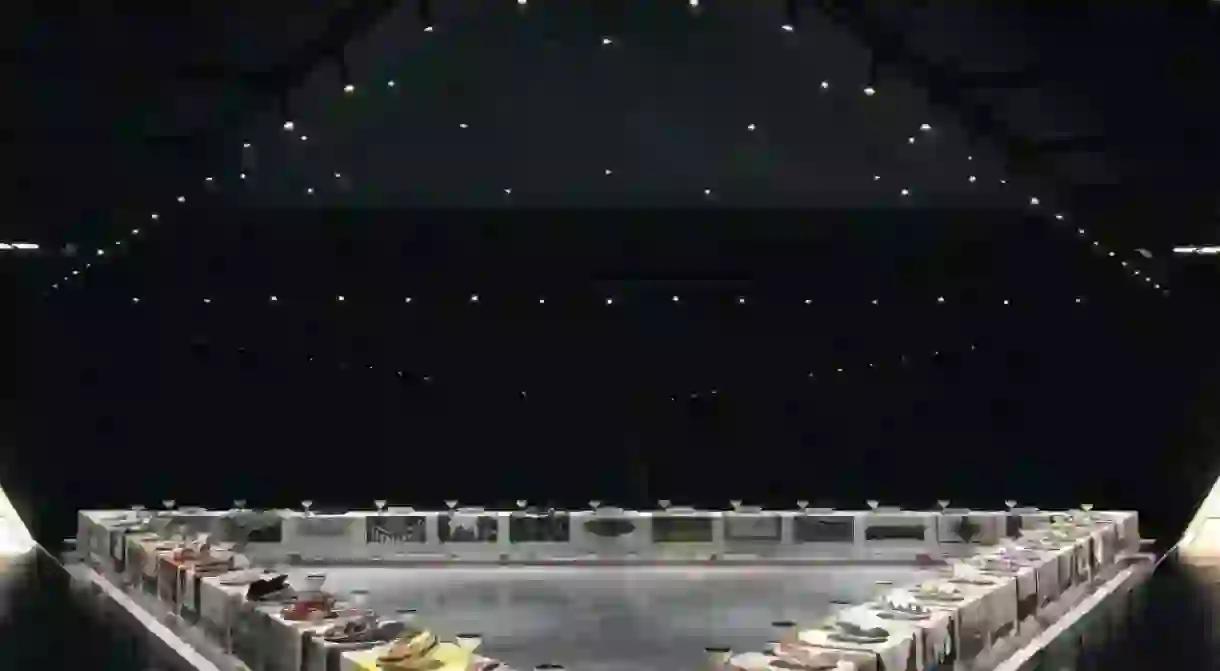10 Famous Artworks At NYC’s Brooklyn Museum

With its eclectic assemblage of artworks and exhibitions, the Brooklyn Museum is a unique place, much like the city in which it nests. It defies all the stigmas of a traditional museum by not following any sort of linear presentation, thus offering a truly one-of-a-kind experience. Everything from traditional Egyptian and African art, to contemporary art by today’s trending artists, can be found covering the floors and walls of this museum. With so much to see and do, here is a list of ten must-see artworks currently being exhibited at the Brooklyn Museum.

KAWS: ‘Along the Way’
Brooklyn-based artist, KAWS, couples pop culture with fine art in many of his paintings, so it comes as no surprise that he does the same in his large-scale sculpture, ‘Along the Way.’ Standing at eighteen-feet tall, Along the Way is a wooden sculpture that portrays two Mickey Mouse-like creatures embracing each other. KAWS approaches the classic cartoon creature in a refreshing new way, while still keeping the essence of the character alive.

Coffin in the Form of a Nike Sneaker
This coffin sculpture, crafted by Ghanaian artist, Paa Joe, demonstrates the tradition of some regions of Ghana to build coffins that reflect personal attributes of the deceased. It is said that the purpose of this practice is to help provide comfort to the deceased as they transition from one world to the next, by giving them something familiar as solace. The significance of this particular coffin, shaped like a Nike Air Max 95 sneaker, is to signify modernity and higher status.

Woman in Gray (Femme en Gris)
‘Woman in Gray (Femme en Gris)‘ is one of Pablo Picasso’s paintings, created during the World War II time period. In this particular portrait, the woman has large disproportioned nose and breasts, as well as mismatched eyes, while a grey and black wide-brimmed hat adorns her head. According to art scholars, the extreme distortions of the woman depicted in the picture is Picasso’s abstraction of the violence and despair that encapsulated the lives of those living in Paris when it was occupied by the Germans.

Religion Enthroned
This large stained-glass window by J&R Lamb Studios depicts religion personified, seated at the center focal point of the artwork. Archangels Michael and Gabriel are on either side of ‘religion,’ embodying the Church Militant (or the body of Christians on earth struggling against sin), and the Church Triumphant (those who are in heaven). The vivid colors within the glass have a lifelike effect, especially when the light shines through them.

Standing Woman
In 1912, French sculptor Gaston Lachaise began modeling sculptures inspired by his muse and wife, Isabele Nagle. His most famous work, ‘Standing Woman‘ portrays a voluptuous nude female sculpted out of bronze. Lachaise often focused on celebrating the female physique by sculpting women with a bold and powerful presence accompanied by delicate features.

The Dinner Party
‘The Dinner Party‘ is a permanent installation by Judy Chicago highlighting feminist art, and which honors important women throughout history. This massive banquet room consists of 39 place settings with painted porcelain plates, all featuring designs inspired by the reproductive female anatomy, and each created according to the style of the woman being honored. Each place comes complete with embroidered table runners, chalices, and silverware, all arranged along a gigantic triangular table. In the center of the room, names of an additional 999 women are inscribed in gold on the white tiles on top of which the table rests. A total of 1,038 women are celebrated in the feminist empowered exhibition.

The Spacelander
British industrial designer, Benjamin Bowden designed this rare bicycle in 1946. As part of its futuristic style, the bicycle is composed of fiberglass instead of the standard aluminum, making it much more fragile than the common bicycle. The Spacelander wasn’t put into production until 1960, and it was commercially unsuccessful; however, it became a popular collector’s item around 1980. The name coincided nicely with the competition going on during the Cold War between the United States and the USSR to be the first to explore space. Due to the limited amount of prototypes manufactured (there are only about 500 in existence), it has become one of the mid-twentieth century’s most sought-after industrial designs.

Coney Island: Visions of an American Dreamland, 1861-2008
This exhibition consists of over 140 objects that explore Coney Island’s history as a popular destination and a model of American culture. Consisting of prints, paintings, and even amusement park objects like carrousel animals, this exhibition walks you through the many transformations that Coney Island has undergone over the course of the past 150 years, including its decline and now revival as the community around it continues to develop and thrive.
Go
Kehinde Wiley is largely known for his highly realistic portraits of black men associated with hip-hop culture, juxtaposed with traditional European paintings. He replaces religious and heroic historical figures with young African-Americans, thus challenging the typical portrayals and representations of people of color. In the ceiling mural titled ‘Go,’ five young black men, garbed in jeans, t-shirts, sneakers, Timberland boots, and do-rags, float through a mirage of clouds holding angelic-like poses, while halo-esque objects encircle their heads.

Stephen Powers: Coney Island is Still a Dream (To a Seagull)
Museum, Shop
By Ameena Walker
New York City native, Ameena is always on the prowl for her next excursion. A food fanatic, Ameena thoroughly enjoys trying new cuisine, whether it is experimenting in her kitchen or scouring the streets of New York. When not enticing her inner foodie, Ameena enjoys being outdoors when weather permits, painting, reading, writing, exercising, and getting up-to-date on all the latest fashion and natural hair hype.













